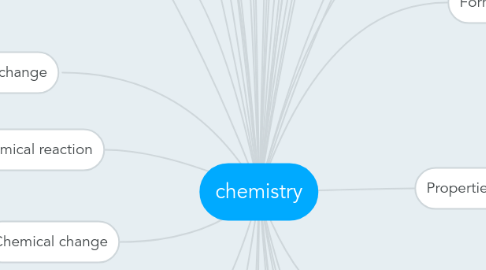chemistry
af Gabriela Melendez


1. alloy
1.1. A mixture of 2 or more metals (Gold and silver are mixed together to make gold stronger
2. 4 points of particle theroy
2.1. The particles in a substance attract each other
2.2. Particles present in matter are always in motion
2.3. All particles have spaces between them
2.4. All matter is composed to very tiny objects called particles
3. Combustibility
3.1. Ability of a substance to quickly react with heat and light
3.1.1. Chemical property
4. 4 points about atoms John Dalton used to explain the nature of matter
4.1. All matter is made up of small, indivisible particles called atoms
4.2. All the atoms of an element are identical in properties
4.3. Atoms of different elements have different properties
4.4. Atoms have different elements that can combine in specific ways to form new substances such as size and mass
5. Chemical change
5.1. Gas produced
5.2. Odour
5.3. Production of light
5.3.1. Chemical property
5.4. Results in the formation of a new substance(s)
6. Physical change
6.1. affecting the form of a chemical substance, but not its chemical composition
6.2. eg. water turns into ice which turns into water vapour
7. matter
7.1. 3 states
7.1.1. solid (Particles are close by a strong force)
7.1.2. liquid (Particles are farther apart with a weaker force)
7.1.3. gas (particles are really far apart with a weak force)
8. chemical reaction
8.1. Process in which chemical change occurs
8.1.1. Chemical property
9. matter changes between the 3 stages
9.1. Solid to liquid (Melting) o Liquid to gas (Evaporation) o Gas to liquid (Condensation) o Liquid to solid (Freezing) o Solid to Gas (Sublimation) o Gas to Solid (Deposition)
10. John Dalton
10.1. Matter is made of small indivisible atoms
10.2. Atoms of an element are identical in properties
10.3. Atoms of different elements have different properties
10.4. Atoms of different elements can combine to form new substances
11. J.J Thomson
11.1. Used a cathode ray
11.2. Discovered electrons
11.3. Reasoned that all elements contain electrons
11.4. Atoms were composed of smaller particles
11.5. Created Thomson’s model
12. Earnest Rutherford
12.1. Shot positively charged particles at pure gold
12.2. Discovered the Nucleus
12.3. Revised Thomson’s model
13. James Chadwick
13.1. Each neutron carries about the same mass as each proton
13.2. Discovered neutrons
13.3. Discovered protons
14. Niels Bohr
14.1. Created Bohr diagrams
14.2. Shows that electrons reside in shells and jump between each shell by gaining or losing energy
14.3. Shell 1 has 2 electrons
14.4. Every other shell has 8 electrons
15. Quantum Mechanical Model
15.1. the most recent model shows that electrons exist in specific energy levels as a cloud
16. protons
16.1. Resides in the nucleus
16.2. Has an electric charge of 1+
16.3. Has a relative mass of 1836
17. neutrons
17.1. Resides in the nucleus
17.2. Has an electric charge of 0
17.3. Has a relative mass of 1837
18. classification of matter
18.1. mixture
18.1.1. heterogeneous mixture
18.1.1.1. meachanical mixtures
18.1.1.2. suspensions
18.1.2. homogeneous mixtures
18.1.2.1. solutions
18.2. pure substances
18.2.1. compounds
18.2.2. elements
19. Homogenous mixtures
19.1. look the same throughout
20. Heterogeneous mixtures
20.1. can be seen with different parts
21. physical properties
21.1. Colour and lustre
21.2. Conductivity
21.3. Density
21.4. Ductility
21.5. Hardness
21.6. Malleability
21.7. Viscosity
21.8. Transparency
22. electrons
22.1. Resides in energy levels surrounding the nucleus
22.2. Has an electric charge of 1-
22.3. Has a relative mass of 1
23. CFC’s
23.1. was a gas used in old refrigerators that destroys the ozone layer when leaked.
24. metals
24.1. Shiny
24.2. Silver or grey in colour
24.3. Excellent conductors
24.4. Malleable
24.5. Ductile
25. non-metals
25.1. Not shiny
25.2. Not silver/grey
25.3. Not shiny
25.4. Not malleable
25.5. Not ductile
26. metalloids
26.1. Has metallic and non-metallic properties
26.2. Semiconductors
27. element symbols
27.1. Each element has a special symbol
27.2. First letter is capitalised; second letter is not
28. atomic number
28.1. The number of protons in an atom of an element
29. Atomic mass
29.1. The average mass of an element’s atoms
29.2. Given in atomic mass uits
30. Ions
30.1. Becomes a positive ion when it loses electrons
30.2. Becomes a negative ion when it gains electrons
31. periods
31.1. Each horizontal row in the periodic table
32. groups
32.1. each column in the periodic table
32.2. noble gases, halogens, alkali metals.
33. Lewis structure
33.1. Shows the valence electrons of an atom
33.1.1. Valence electrons are the outermost electrons
